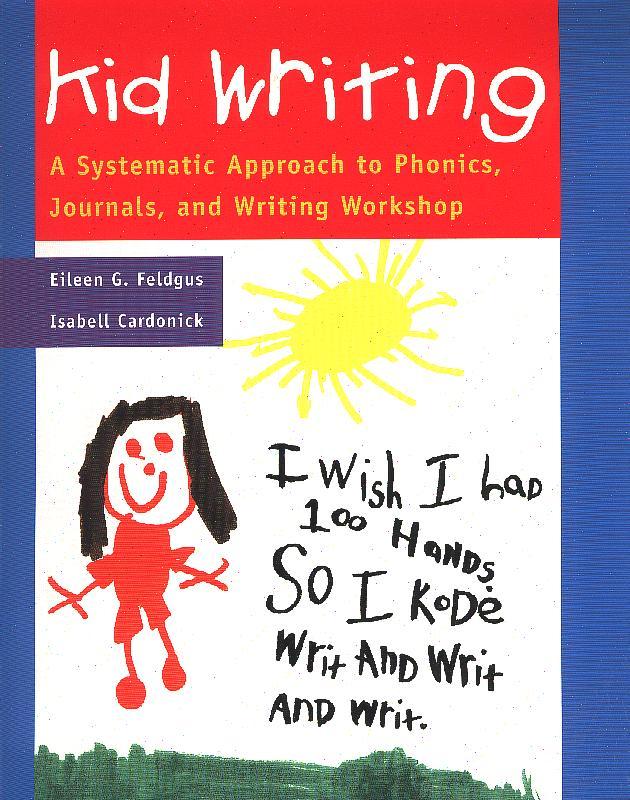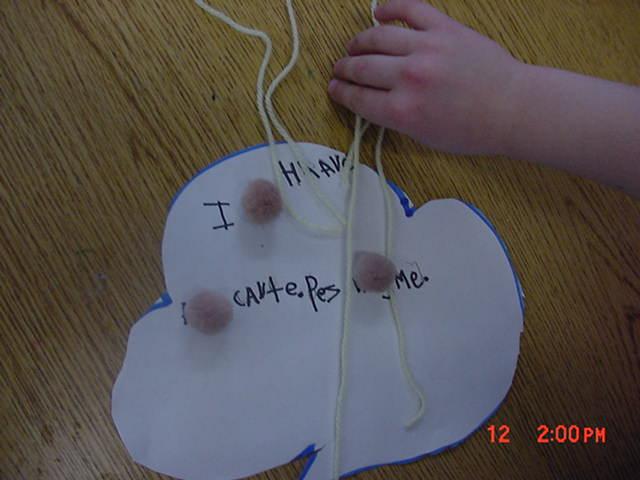|
| |
 |

SPELLING DEVELOPMENT
|
| |
Kid Writing

In Portsmouth we have gladly taken on the joy of
Kid Writing created by Eileen G. Feldgus and Isabell Cardonick. Kid Writing presents a new vision for systematic phonics instruction and
assessment. This is our second year of implementing this systematic
approach, and the teachers are enjoying the process as much as the children
are. Click here to view the
Philosophy of Journal Writing which is the underlying basis for Kid
Writing.
I will attempt to share with you some of the ideas that
are essential in Kid Writing, as we encompass them ourselves in the classroom.
Spaghetti and Meatball spaces are very important in spacing between letters
and words.

The children used yellow yarn and small brown pompoms in
the beginning to help them visualize the spaces between letters in words and
words in sentences.
The children also have hats or Kid Writing crowns to help them with their
writing. Click here to view Kid Writing Crowns.
|
| The process of learning to write by
writing by Donald Graves is the underlying philosophy of the reading-writing
process in our Kindergarten classrooms. Journal writing is an ongoing event as
children decide on topics, illustrate it by drawing, and then use invented or
phonetic spelling to describe the illustrations. |
| The children are so proud when they "reread" what they have
written. I have learned how to decipher their beginning efforts and you will
too. The hope is that you as parents will reinforce through praise the child’s
efforts. So often as parents you expect correct spelling and do not realize that
spelling is developmental. In order to help you understand the process, here is
an outline of the stages of developmental spelling. Formal assessment and
rubrics will not be evaluated until March. When a writing, journal or book
come home, I will assign a number in the upper right corner of the paper,
indicating what level I believe the child to be writing at. Refer to this
outline as a guide to your child's development in writing. |
Stages of Spelling Development (J.
Richard Gentry)
What follows are descriptions of the five stages of spelling development
identified by Gentry: |
| 1. Precommunicative:
Precommunicative spelling is used to describe writing that only conveys
meaning for the child who wrote it. At this stage, the child conveys a
message through scribbles, shapes, drawings, and/or letters that are strung
together randomly and does not know that letters represent sounds.
Examples: PRT = cake, RLFP = type. |
| 2. Semiphonetic:
Semiphonetic spellers know that letters represent sounds. The word
semiphonetic is used to indicate that these spellers write only some
of the letters in a word. They very often use an initial consonant to
represent a whole word. They may or may not put spaces between words
Examples: K= cake, t = type, MBEWWLNT = My baby was with me last
night. |
| 3. Phonetic: Phonetic
spellers spell words the way they sound. They write all the sounds
they hear in words. These spellings do not necessarily look like
English spellings, but they are quite readable. Initial and final
consonants are in place, and these spellers gradually add vowels, even
though they may not be correct. Word spacing is evident.
Examples: cak = cake, tip = type, caek = cake, It trd in to a brd = It
turned into a bird. |
| 4. Transitional:
Transitional spellers begin to write words in more conventional ways.
These spellers undergo a transition from reliance on sound to reliance on
visual memory of how the word looks in print. They write with more
correct vowels in every syllable. Often, all the letters necessary to
spell the word are there, but some letters may be reversed.
Examples: tipe = type, caek = cake, huose = house, opne = open. |
| 5. Conventional:
Conventional spellers develop over years of word study, reading, and
writing. Their knowledge of the spelling system is firmly established.
These spellers know when words don't look right, and they experiment with
alternatives. They spell a large number of words automatically.
Conventional spelling is a lifelong process. |

|
